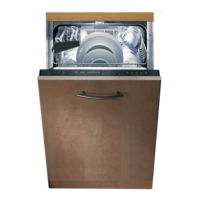
Do you have a question about the V-ZUG Adorina 45 and is the answer not in the manual?
| Brand | V-ZUG |
|---|---|
| Model | Adorina 45 |
| Category | Dishwasher |
| Language | English |
Check packaging for damage, dispose of materials properly, and ensure correct contents.
Connect appliance correctly, ensure stable installation under worktop, and accessible mains plug.
Handle sharp utensils safely, avoid leaning on the door, and be cautious with children.
Keep children away from the appliance and cleaning agents to prevent injury or poisoning.
Repairs must be done by qualified specialists after disconnecting power and water.
Details the function of each button and indicator on the control panel.
Identifies the various parts within the dishwasher, including baskets and spray arms.
How to determine tap water hardness and set the water softener accordingly.
Instructions for filling the salt dispenser before the first use to prevent corrosion.
Explains the low salt indicator and when to refill the salt container.
How to adjust the rinse aid dispenser control to avoid streaks or water marks.
How to identify when rinse aid needs to be refilled based on the indicator light.
Lists items like wooden cutlery, sensitive glasses, copper, and plastic unsuitable for dishwasher cleaning.
Causes of damage to glassware and dishes, with suggested remedies for prevention.
Tips for using the upper rack only function to save energy and water.
Guidelines for placing items in the dishwasher to ensure effective washing and prevent tipping.
Recommendation to empty the lower basket first to prevent water dripping onto dishes.
Specific guidance for loading cups, glasses, pots, pans, cutlery, and folding spikes.
How to adjust the top basket's height to gain more space in either basket.
Instructions for using the shelf accessory and small accessories holder.
Steps to adjust top basket height using side levers, ensuring level insertion.
How to clean large baking sheets and grilles using the special spray head.
Information on different types of dishwasher detergents and their properties.
Explanation of the detergent compartment, its capacity, and measuring marks.
Instructions on filling the detergent dispenser and important notes on tablet usage.
Important considerations for using combined cleaning products like those with built-in rinse aid or salt.
Guidance on how to choose the most appropriate wash programme based on crockery and food remains.
Information on programme specs and steps to turn the dishwasher on.
Describes optical indicators, programme end, and how to switch the dishwasher off.
How to safely interrupt, cancel, or change programmes during operation.
Routine checks on machine condition, including spray arms, seals, and cleaning precautions.
Checking and refilling special dishwasher salt and rinse aid as indicated.
How to clean filters to prevent pump blockages and ensure correct re-installation.
Checking for spray arm blockages, removing, cleaning, and refitting them.
Identifying pump blockages caused by food remnants and steps to clear them.
Guidance on resolving common problems yourself and safety warnings for repairs.
Common reasons why the appliance might not start, such as fuse trips or door not shut.
Troubleshooting issues with spray arms, detergent lid closure, and indicator lamps.
Addressing excessive foam, sudden stops, knocking, and rattling sounds during washing.
Causes and solutions for food residue, plastic discoloration, and stubborn stains on dishes.
Addressing issues with dishes not drying, white spots, dullness, and clouded glasses.
Troubleshooting rust on cutlery and metallic smears on glasses and cutlery.
How to contact customer service and the essential details to provide.
Important note that service visits for faults are not free of charge, even during the warranty period.
Information on comparison test conditions and general installation notes.
Requirement for qualified installation and the sequence of connection steps.
Connecting waste water, fresh water, and details on pressure, flow rate, and temperature.
Instructions for connecting to the power supply, including safety requirements.
Checks upon delivery and final adjustments to ensure the appliance is level and firm.
Step-by-step procedure for safely disconnecting and removing the appliance.
Guidelines for safe transport and protecting the appliance from freezing temperatures.
Information on recycling old appliances, making them inoperable, and environmentally friendly disposal.
Instructions for environmentally friendly disposal of packaging materials, keeping children away.
Making redundant appliances unusable and disposing of them in an environmentally friendly manner.
Guidance on using troubleshooting for minor repairs and when to call a service engineer.
Essential details to provide when contacting service, like model and serial numbers.
Where to find model and serial numbers on the appliance door identification plate.